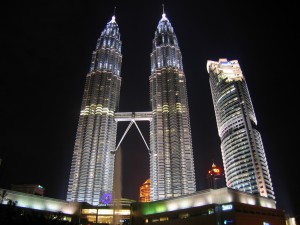By Mark Irving www.au.news.yahoo.com
Mention skyscrapers and Kuala Lumpur in the same sentence, and thoughts inevitably turn to the Petronas Towers.

And why wouldn’t they? At 452m, the twin towers, built in 1998, are not only stunning in appearance but ranked as the tallest buildings in the world until 2004 when they were surpassed by the Taiwanese megabuilding, Taipei 101. At 509m, Tapei 101’s spire added another 57m to the world mark, and Petronas duly lost its top-dog status. At 828m, Burj Khalifa in Dubai has now eclipsed this.
Looked at from ground level, Petronas is still mighty impressive, and a walk across its skybridge, at the 41st floor level, is said to be pretty awesome.
However, the number of visitors who can make that “skywalk” is restricted to only 1700 a day and if you’re not early, you may miss out.
But if you want to see Malaysia’s capital from on high, there’s another place only a 10-minute cab ride away that also gives great views: the Menara communications tower, also known as the Kuala Lumpur Tower, sometimes called Menara Kuala Lumpur.
It’s in the centre of KL, close to many big hotels and the city’s financial district, on the quaintly named Pineapple Hill, and it was built to bring KL’s communications and broadcasting capabilities up to scratch.
At the top is an antenna which takes its total height to 421m, putting it up there with the world’s tallest communication towers.
Take a lift and within a minute you arrive at the Tower Head’s Observation Deck – a lofty perch 276m above the ground from where you can survey this bustling Asian metropolis. It’s some metropolis: KL spreads over 250sqkm and contains some 1.5 million “KLites”, as they’re known locally.
It’s wider conurbation, however, includes seven million people. KL is the fastest growing city in the country – one reason why it’s dubbed by sociologists as an “alpha city”, meaning a city of significant global importance.
The architecture of Menara tower itself is a fine example of a mix of east and west, including the lift lobby which includes an impressive dome ceiling made of hundreds of glass crystals. Made in Isfahan, Iran, one of KL’s twin cities, they sparkle like diamonds and follow the shape of traditional Islamic muqarnas – an Islamic architectural technique to depict the seven layers of the sky and sun and to symbolise Man’s journey towards perfection.
Back to reality, and we joined a quick queue for one of the four express elevators. It was to take 58 seconds but we timed our ear-popping ride at less, both ascending and descending. Taking the stairwell’s 2058 steps would take a tad longer, though athletes do it fast enough during annual races.
Menara tower has also become noted for hosting an annual BASE jump event. The first was three years after the building opened; this year’s will be held from the end of September through to the beginning of October.
Walking around the Observation Deck gives a real sense of KL’s size and energy and visitors can enjoy a guided tour via an audio guide and gaze at this activity through telescopes.
There’s much to see. Apart from the impressive mosques, there’s an abundance of sparkling skyscrapers and the shopping malls which make KL such a popular destination for Australians. But among the hustle and bustle below there’s also a tiny pocket of nature.
Actually, it’s a decent-sized pocket- 9.37ha pocket, to be precise, and it’s Malaysia’s oldest gazetted forest reserve, surrounding the tower and smack bang in the centre of the city. Rather like Perth’s Kings Park, it’s been maintained as a reserve to ensure a balance in the mix of nature and development.
Justifiably proud of the tower, Malaysians also are proud of saving a rare jelutong tree during its construction. The jelutong has been overharvested in the past and is protected in parts of the country. This particular tree is estimated to be 110 years old and the site of the tower was shifted slightly during its planning stage, and a protective wall built. In all, about RM430,000 ($140,000) was spent to preserve it.
On the Observation Deck, you can watch a short video in the theatrette about the quick-fire building of the tower. It began in the early 1990s, and the construction phase took only a couple of years.
There’s no surprise when the statistics are reeled out to demonstrate the enormousness of the project: 50,000cum of soil were moved, for example, and 5500cum of concrete laid, courtesy of 84 concrete mixer trucks. The whole thing was finished by mid-1996.
There are, of course, the inevitable souvenir shops as well as, on the next floor, the inevitable revolving restaurant.
Perhaps dinner at that restaurant is the best time to see the city below when the haze gives way to the city’s lights. It’s said you can see the Strait of Malacca from the Observation Deck but there was no chance the day we visited.
But whether you go by night or day (and have walked the Petronas skybridge or not), it’s a visit well worth making.












